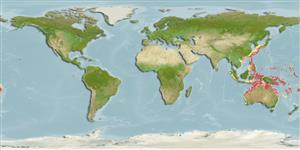Classification / Names
Common names from other countries
Main reference
Size / Weight / Age
Max length : 40.5 cm SL male/unsexed; (Ref. 2687)
Environment
Marine; benthopelagic; depth range 52 - 90 m (Ref. 34024)
Climate / Range
Tropical, preferred ?
Distribution
Short description
Dorsal
spines
(total): 0;
Dorsal
soft rays
(total): 94-96;
Anal
spines: 0;
Anal
soft rays: 71 - 73;
Vertebrae: 51 - 52. Ontogenetic change in color pattern occurs; small individuals with horizontal bands on body; bands assuming a vermiculate pattern on medium-sized fishes; becoming blotched or slightly vermiculate in large specimens. 3-4 developed gill rakers. Small body scales arranged in 130-145 regular rows along the side; base of pectorals with scales, none on bases of vertical fins. Dense, small, fleshy papillae on lips. Supraorbital pores 2; suborbital 5 ?; lateral 1; preoperculomandibular 8; temporal 1. Pyloric caeca numerous, about 45.
IUCN Red List Status (Ref. 115185)
Threat to humans
Harmless
Human uses
Fisheries: of no interest
More information
ReferencesAquacultureAquaculture profileStrainsGeneticsAllele frequenciesHeritabilityDiseasesProcessingMass conversion
Tools
Special reports
Download XML
Internet sources
Estimates of some properties based on models
Phylogenetic diversity index
PD50 = 0.7500 many relatives (e.g. carps) 0.5 - 2.0 few relatives (e.g. lungfishes)
Trophic Level
3.6 ±0.6 se; Based on size and trophs of closest relatives
Resilience
Medium, minimum population doubling time 1.4 - 4.4 years (Preliminary K or Fecundity.)
Vulnerability
Moderate vulnerability (45 of 100)
Price category
